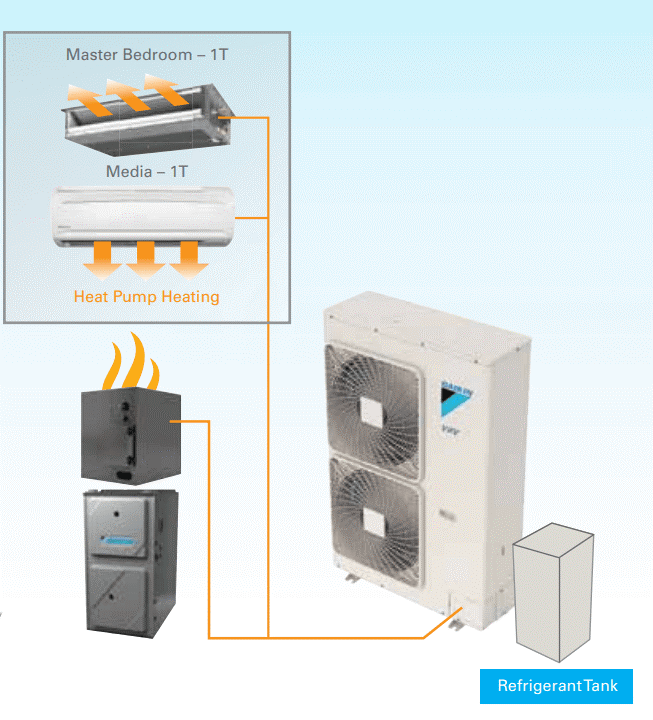BENEFITS OF DUAL-FUEL HYBRID HEATING NEAR EAST DUNDEE, IL

The main benefit of dual-fuel hybrid heating systems is they use less energy than traditional furnaces. That lowers your energy bills. You also get better heating throughout your house, and stay warm even in sub-zero temperatures.
Energy consumption is a hot topic today. It’s an important consideration whether you’re concerned about the environment, or just trying to keep your monthly home expenses down.
Plainly put, the less energy you use, the less impact you have on the world around you. And, the less you pay on your monthly utility bills.
Here in East Dundee, Barrington, and other Chicagoland suburbs, fuel consumption is a significant expense in the wintertime. The last few winters have been especially brutal, and it doesn’t look like that’s changing anytime soon.
But, what if you could spend less on heating while making your home even more comfortable?
Daikin VRV Life in the Fox River Valley
It’s possible with dual-fuel hybrid heating — in particular, with the Daikin VRV Life system.
At Compass Heating and Air, we’ve served every type of home in the Fox River Valley, from town houses and ranches to colonials and luxury homes.
After seeing the challenges each housing type presents in this climate, we’re convinced that Daikin VRV Life is the best option for homes around here.
In this post, we’ll explore what these HVAC systems do, exactly. Then, we’ll look at the benefits they offer. And, we’ll even give you some estimates on how much money you can save.
What is a Dual-Fuel Hybrid Heating System?

A dual-fuel hybrid heating system is an HVAC system that alternates between two energy sources to provide warmth. Most homes have oil, gas, or electric heat. Instead, the dual setups use an electric heat pump but switch to a secondary source when necessary.
Think of it like a hybrid car. The attraction there is that it runs on electricity, which costs less than gasoline. But, sometimes the car switches over to regular gas. Even still, it uses less energy — and costs less to run —- than a traditional automobile.
In this case, you use a heat pump for the bulk of your heating and cooling needs. These have their benefits and drawbacks. But, they work even better as part of a dual system.
Heat Pumps and Chicagoland Winters
The gist of it is that it moves thermal energy from one place to another. In the winter, it gathers whatever heat there is outside and sends it inside. It uses a compression system to amplify that energy so it’s enough to get your home to the temperature you want.
But, they do have their limits, and that’s usually around negative 13 degrees. In some places of the country, that’s never a problem. But, those places aren’t Northern Illinois.
It hasn’t been unusual for us to get weather even colder than that in January and February. That means there are times a heat pump won’t work in the dead of a Chicagoland winter.
So, you want to switch back and forth from a heat pump to gas heat. This way, you’re using the more efficient source most of the time. Then, the system automatically kicks on your furnace when it needs more power.
What is Daikin VRV Life?
VRV stands for “variant refrigerant volume.” Without getting too technical, this means the system doesn’t always use the same amount of resources whenever it’s on. Instead, it will use less refrigerant at times. You save money because it costs less to run.
We can use another car metaphor to explain this: Cruise control.
Your average furnace has two settings: On and off. The temperature dips below the thermostat’s setting, the system turns on. The temperature reaches the thermostat’s call; the furnace turns back off.
It cycles through this process a few times per hour.
With VRV, your system can also run in a low-power mode. That setting maintains the temperature rather than switching on to correct it and then turning back off. The consistency uses less energy than working extra when the room starts getting chilly again.
It’s like how cruise control lets the car make subtle, automatic adjustments. It’s less energy and less wear and tear than toggling the gas and the breaks.
Better Heating With Zoned HVAC

The next benefit of Daikin VRV is creating zoned HVAC for more comfortable heating. What this means is that you’re treating each part of your house individually instead of with one thermostat.
You do this by installing air handers throughout the house. If you’ve heard of a mini split, that’s what this is: The heat pump is one part of the split system, while the air handlers are the other.
These units usually mount to the wall and connect to the heat pump. They act as the vents, circulating the air in the room.
But, they do a much better job than a literal hole in the wall. And, each one has a built-in thermostat. That’s how you get the zoned effect.
This way, each room gets the treatment it needs, instead of the whole house relying on one gauge in the living room. If your bedrooms are colder than the living room in the winter, this how you fix it.
How Does It Work With a Gas Furnace?
With Daikin VRV, you can still use your existing ductwork with the air handlers and heat pump. Overall,the heat pump does most of the work. And, the variant refrigerant flow makes sure you use as little energy as possible.
Now, occasionally, you’re better off using a gas furnace. Even though it’s less efficient, you need that extra firepower.
That’s when the system temporarily switched over to fossil fuel. Once the temperature’s back where it should be, it goes back to using the heat pump.
It’s nothing you need to do — the system does it automatically, just like how your thermostat turns the furnace or air conditioner on and off now.
How Much Money Can I Save With Dual-Fuel Hybrid Heating?
Rebate Opportunities
Depending on what you get, you can get up to $400 for a mini split, and $400 to $600 for the heat pump.
There are some specifications about what equipment qualifies, of course. You’ll want to read the fine print and make sure you have all the proper documentation when you apply.
Fortunately, Compass is a certified ComEd provider. We’ll make sure you get any rebates available.
Lowering Your Monthly Bills
Now, what happens with your energy bills? Well, it varies from house to house. But, under the best conditions, we’ve seen up to 300 percent energy efficiency. That means that when you spend $1 on heating, you’re getting the same amount of heat that used to cost $3.
It’s still a big decision. But, we’ve seen time and again how well it works out here. If you’re interested in learning more, or have any questions, reach out to Compass Heating and Air today. With a free consultation, we’ll help you choose the system that will work best for your home.


